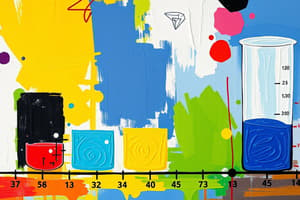Podcast
Questions and Answers
What pH value is considered neutral?
What pH value is considered neutral?
- 7 (correct)
- 6
- 14
- 0
Acids have a pH greater than 7.
Acids have a pH greater than 7.
False (B)
What happens when an acid reacts with a base?
What happens when an acid reacts with a base?
A neutralization reaction occurs to form water.
A solution with a pH of 3 is considered a ______ acid.
A solution with a pH of 3 is considered a ______ acid.
Which of the following substances is a strong acid?
Which of the following substances is a strong acid?
Match the following acids or bases with their characteristics:
Match the following acids or bases with their characteristics:
Buffers in the body help to maintain the pH within a normal range.
Buffers in the body help to maintain the pH within a normal range.
What ions do bases produce when they dissolve in water?
What ions do bases produce when they dissolve in water?
What pH value indicates a neutral substance?
What pH value indicates a neutral substance?
Acids have a pH greater than 7.
Acids have a pH greater than 7.
Name one of the four major elements that constitute about 96% of the body’s mass.
Name one of the four major elements that constitute about 96% of the body’s mass.
Substances with a pH lower than 7 are known as __________.
Substances with a pH lower than 7 are known as __________.
Match the following elements with their corresponding properties:
Match the following elements with their corresponding properties:
What happens when bicarbonate combines with excess hydrogen ions?
What happens when bicarbonate combines with excess hydrogen ions?
Alkalis produce hydroxide ions (OH–) when dissolved in water.
Alkalis produce hydroxide ions (OH–) when dissolved in water.
What is the role of iodine in the body?
What is the role of iodine in the body?
What is active transport?
What is active transport?
Larger molecular sizes result in faster diffusion rates.
Larger molecular sizes result in faster diffusion rates.
What is homeostasis?
What is homeostasis?
The normal levels of glucose in the blood are maintained between ______ mg/100 ml.
The normal levels of glucose in the blood are maintained between ______ mg/100 ml.
Match the following components of homeostatic regulation with their functions:
Match the following components of homeostatic regulation with their functions:
Which of the following factors does NOT influence diffusion rates?
Which of the following factors does NOT influence diffusion rates?
Positive feedback mechanisms are primarily responsible for maintaining homeostasis.
Positive feedback mechanisms are primarily responsible for maintaining homeostasis.
Give an example of negative feedback in human physiology.
Give an example of negative feedback in human physiology.
Flashcards are hidden until you start studying
Study Notes
pH Scale
- Measures hydrogen ion (H+) concentration, indicating acidity or alkalinity.
- Ranges from 0 (strongest acid) to 14 (strongest base), with 7 being neutral.
- Acids have a pH lower than 7, with lower numbers indicating stronger acids.
- Bases have a pH greater than 7, with higher numbers indicating stronger bases.
- Neutral solutions have a pH of 7.
Acids
- Turn blue litmus paper red.
- Turn universal indicator paper red (strong) or orange/yellow (weak).
- Strong acids are corrosive, examples include battery acid and hydrochloric acid.
- Weak acids are irritants, examples include tomato juice and black coffee.
- Produce hydrogen ions (H+) when dissolved in water.
Bases
- React with acids to neutralize them.
- Bases dissolved in water are called alkalis.
- Turn red litmus paper blue.
- Turn universal indicator paper dark blue/purple (strong) or blue-green (weak).
- Produce hydroxide ions (OH-) when dissolved in water.
Acid-Base Balance in the Human Body
- Cellular processes function optimally within a pH range of 6 to 8.
- Changes in pH can denature proteins, affect enzyme activity, alter hormone action, and disrupt cell/tissue function.
- The body has a buffer system to maintain acid-base balance.
- Common buffers include bicarbonate (HCO3-) and carbonic acid (H2CO3).
Homeostasis
- The body's ability to maintain a stable internal environment despite external changes.
- Achieved through regulatory processes that detect imbalances and restore balance.
- Necessary for survival as extended imbalances lead to disease and death.
- Examples include blood glucose regulation through insulin and glucagon.
Components of a Homeostatic Mechanism
- Receptor: Detects changes in the internal environment.
- Control centre: Processes information from the receptor and initiates a response.
- Effector: Carries out the response to restore balance.
Feedback Mechanisms in Homeostasis
- Negative feedback: Reduces the effect of a stimulus, restoring balance.
- Positive feedback: Amplifies the effect of a stimulus, leading to a specific outcome.
Elements in the Body
- 92 elements exist in nature, with hydrogen to uranium.
- Each element has a chemical symbol, usually 1 or 2 letters.
- Four major elements (oxygen, carbon, hydrogen, nitrogen) make up 96% of body mass.
- Eight lesser elements (calcium, phosphorus, potassium, sulfur, sodium, chlorine, magnesium, iron) contribute 3.6% of body mass.
- Trace elements are present in small amounts but have important functions (e.g., iodine for thyroid hormone production).
Studying That Suits You
Use AI to generate personalized quizzes and flashcards to suit your learning preferences.




